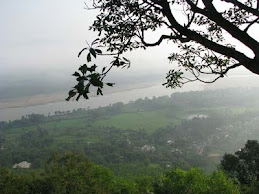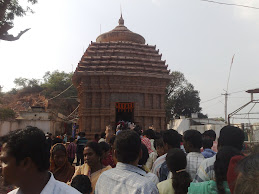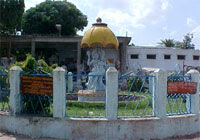Saturday 28 November 2009
Thursday 26 November 2009
LADY OF THE RESTLESS WATERS
Ensconced in the foothills of the Sahyadris and lapped by the Arabian Sea along a palm-fringed coast interrupted at places by the estuaries of the Mandovi, Zuari and other rivers, Goa has been an entrepôt of renown. The cultural links between water and worship in coastal Goa are, indeed, many. The religious lore of this land contains references to maritime festivals and deities. A unique component of the cultural legacy of Goa is the ‘maritime’ Mahishasuramardini of the Mhadei, the exclusive ‘boat deity’ of the Mhadei river valley. The earliest references to this deity can be traced to the early medieval period, when the Kadamba dynasty ruled over the region.
I have studied and documented fifteen sculptures in which a female deity, who is worshipped locally as Santeri/Shantadurga, Jogeshwari, Navadurga, or as an anonymous parivar devata, is depicted either seated atop or standing in a boat (one of them even sits on a boat shaped like a fish); two images of Gajalakshmi with howdahs in the shape of a boat; three sculptures of Brahmanimaya with a boat carved on the pedestal, and six of male deities who are shown either standing fully armed, with a boat etched on the pedestal, or riding a horse positioned above the boat-like pedestal. Most of these Devi sculptures have votive origins. In the absence of a distinct local epithet for these deities, I have referred to the boat-goddess as Tarini and the boat-god as Tar-Vir, alluding to the cultural and iconographical similarities with the famous goddess Tara-Tarini of the Orissa coast.
The worship of Tara and Tarini is found in Orissa’s Ganjam district (which has the famous ancient Tara-Tarini temple), Ghatgaon and Ratnagiri (where the Astamahabhaya Tara is worshipped). These are the patron deities of sailors and merchants. Tara is worshipped by sailors for safety and success at sea along the Orissa coast. The Ratnagiri Tara is believed to save her devotees from eight great fears, one of which is of shipwreck. Yet another fear, jalarnavabhaya, is of drowning in a sinking vessel.
Unlike in Orissa, the ‘boat deities’ of Goa, Tarini and Tar-Vir, are found away from the coast, in the sub-Ghat talukas of Sattari and Sanguem, against the backdrop of the Sahyadri mountains, in the villages of Keri, Bhuipal, Nagvem, Zarme, Sonal, Sanvarde, Bhironda, Dhamshe, Guleli, Shayll-Melauli, Malpann in Sattari; Ganjem in the Ponda; and Barabhumi, Surla and Talldem of Sanguem.
The spots where the sculptures have been found are almost always located along the banks of the Mhadei and its tributaries, lying either inside a temple or, weather-beaten in the open, amidst lush greenery, in the vicinity of a stream, and often in the periphery of the devarai or the sacred grove, and, in one instance, outside the Bondla wildlife sanctuary.
Almost all the images have been carved out of schist stone, locally known as pashaan. Local temple architects and sculptors were engaged to carve these images. Hence, the iconography of the sculptures found in the Mhadei valley bears a clear local influence, introduces a Sattari flavour or creates an amalgam of various artistic forms and iconographies from different belief-systems, (folk, Brahmanical, as well as Jain and Buddhist), rather than adhering to the classical forms.
The Devi-in-a-boat is, thus, a unique work. In the Devi Mahamatya, the Devi is hailed as “Durga, the boat that takes men across the difficult ocean of worldly existence, devoid of attachments”. She is also the saviour of one who is “tossed about in his boat by a temp
 est in the vast sea”. Tarini and Tarita are names of Durga. Tarani, which means a boat, is also the Sanskrit word for saviour. The goddess is hailed as Tarini in Arjuna’s hymn to Durga in the Mahabharat. Gayatri, the primal form of Tara or Bhavatarini, is hailed as “bhaya-haarini bhava-taarini” (the one who removes fears and ferries across the river of life). The only maritime reference for Mahishasuramardini is the epithet, “daughter of the ocean”, in the Mahishasuramardini Stotram.
est in the vast sea”. Tarini and Tarita are names of Durga. Tarani, which means a boat, is also the Sanskrit word for saviour. The goddess is hailed as Tarini in Arjuna’s hymn to Durga in the Mahabharat. Gayatri, the primal form of Tara or Bhavatarini, is hailed as “bhaya-haarini bhava-taarini” (the one who removes fears and ferries across the river of life). The only maritime reference for Mahishasuramardini is the epithet, “daughter of the ocean”, in the Mahishasuramardini Stotram.Hence, the association of Tarini with the boat to signify her status as the rescuer of shipwrecked sailors, the protector of riverine traders and others who sailed in the Mhadei. She also spiritually denotes the concept of Tara as the deity who assists souls to ‘cross to the other shore’. The Goan version of Tara-Tarini of Orissa, perhaps? In her many avatars, Tarini as Santeri or Shantadurga is a symbol of fertility; as Ganga, she is the river goddess representing the Mhadei; as Tara, she rescues and ships her devotees to safety; and above all, as Mahishasuramardini, the boat-goddess is the protector, the slayer of the enemies of the local sailors and merchants.
The talukas of Sattari and Bicholim, important points in the trade route, contributed to Goa’s cultural ethos by hosting not just Hindu shrines, but also Buddhist and Jain settlements. Buddhism and Jainism flourished in this region during the ancient and early medieval periods. Kothambi, Kudnem, the caves of Lamgaon, and Colvale at a little distance, were important centres of Buddhism and Jainism. Hence, elements of the Jain Yakshi and Ambika, found their way into the conceptualization and at times, the artistic execution, of the maritime Mahishasuramardini. While we discovered an image of a Buddhist or Jain monk close to the Sanvarde Tarini, the sculpture in Shayll-Melauli displays the image of a Buddhist monk on its base.
The boat-Devi is most commonly found to possess the attributes of an eight-armed Mahishasuramardini, though a couple of sculptures that contain interesting maritime information are chaturbhuja — with four arms. She is either seated on an asana in a boat, or on the boat itself, or is depicted standing in the boat. Almost all the sculptures exhibit human heads in the boat, with boatmen on either side of it, and in the Nagvem sculpture, the oarsmen are actually shown in the act of rowing the vessel.
Other than the ubiquitous boat, most of these sculptures contain related nautical and marine motifs, such as oars, anchors, mast, sail, pennant, fish and crocodile.
The Tarini and Tar-Vir sculptures of the Mhadei, Ragada and Valvanti river valleys provide valuable clues about ancient trade routes and practices, manufacturing centres, riverine ports, types of watercraft used, boat-building traditions and locations, trading communities and cultural interactions that took place as a consequence of thriving commerce.
The discovery of these sculptures has helped me give visibility to the hitherto-largely-undocumented contribution of the talukas of Sattari, Bicholim, Sanguem and Ponda to the commerce of ancient and early medieval Goa and the Konkan coast. Links may even be established between the east and west coasts of India on the basis of the resemblance of the Goan Tarini to Orissa’s Tara-Tarini. The similarities are not confined to the concept of a saviour-deity and the iconography of a goddess-in-a-boat, but extend to other cultural parallels such as boat festivals, and derivation of place-names.
The Tarini and Tar-Vir not only provide valuable clues about the Western Ghats-Arabian Sea trade, of which Goa (Sattari, in particular) had served as an important conduit, but also about the coming together of folk, Sanskritic, Buddhist and Jain traditions, as lo
 cally crafted syncretic saviour-deities for the river traders and boatsmen of the Mhadei.
cally crafted syncretic saviour-deities for the river traders and boatsmen of the Mhadei.Influenced by the play of varied cultural elements, the Mhadei river valley serves as the crucible of the syncretic Tarini. The goddess who is depicted as either standing or seated in a boat, is a rarity in Indian art. The commercial worthiness of the Mhadei, the Buddhist and Jain settlements that dotted the trade routes in the sub-Ghat region, the presence of the local Chari community as divine sculptors — all these contributed to the creation of the unique representation of the goddess-in-a-boat.
The Tarini is thus a syncretic vision of the Shakti of the Mhadei river valley, a saviour-goddess epitomizing the “shared faith” that characterized the cosmopolitan Sattari in the early medieval period. This taluka brought within its fold a surprisingly wide range of local, Sanskritic, Buddhist and Jain traditions — yet another reminder of the inclusive civilization that India once was.
(The author is head of the department of history, Goa University)
Source: The Telegraph
Tuesday 24 November 2009
2nd phase to start at 2nd phase to start at Sthana Peetha Taratarini under new chairman under new chairman
 Bhubaneswar: Revenue Divisional Commissioner (RDC) of Southern Division of Odisha Chandrasekhar Kumar is the new chairman of the Tara Tarini Development Board (TTDB), a prominent temple administration body in Ganjam district. He has taken over from the outgoing RDC and former TTDB chairman Satyabrata Sahu who is now the Commerce & Transport Secretary of the State Government. It was under the guidance of the former chairman that the first phase of the stone temple was completed. This religious shrine is believed to be the Sthana Peetha (Breast Shrine) of Mata Sati and one amongst the four major ancient Shakti centers in India.The new chairman visited the shrine and discussed the commencement of the second phase of work. Board Secretary Pramod Panda along with the other board members tabled the primary draft of the second phase of work and it was decided to finish all on-going work before the upcoming Chaitra MelaThe projects in the second phase include completion of Kalyana Mandapam, construction of huge hill-top parking space, widening of stone steps and arrangement of public utilities or rest houses, maintenance of eco-system, construction of a hospital and the construction of a residential school and training centre for the physically challenged.
Bhubaneswar: Revenue Divisional Commissioner (RDC) of Southern Division of Odisha Chandrasekhar Kumar is the new chairman of the Tara Tarini Development Board (TTDB), a prominent temple administration body in Ganjam district. He has taken over from the outgoing RDC and former TTDB chairman Satyabrata Sahu who is now the Commerce & Transport Secretary of the State Government. It was under the guidance of the former chairman that the first phase of the stone temple was completed. This religious shrine is believed to be the Sthana Peetha (Breast Shrine) of Mata Sati and one amongst the four major ancient Shakti centers in India.The new chairman visited the shrine and discussed the commencement of the second phase of work. Board Secretary Pramod Panda along with the other board members tabled the primary draft of the second phase of work and it was decided to finish all on-going work before the upcoming Chaitra MelaThe projects in the second phase include completion of Kalyana Mandapam, construction of huge hill-top parking space, widening of stone steps and arrangement of public utilities or rest houses, maintenance of eco-system, construction of a hospital and the construction of a residential school and training centre for the physically challenged.Source: The Pioneer
Thursday 19 November 2009
New chairman takes over charge of Taratarini Development Board
TARATARINI DEVELOPMENT BOARD
Regd. No.: GJM No. - 7177-A – 676/2002-2003
Hillpatna, Berhampur – 5, (Ganjam), Orissa
(0680) 2215168, Website: http:/taratarini.nic.in
E-Mail: rdcbmp@ori.nic.in, hillshrine@hotmail.com
------------------------------------------------------------------------------
Shri Chandrasekhar Kumar, IAS and the new Revenue Divisional Commissioner (RDC) of Southern Division, Odisha has taken over the chairmanship of the Tara Tarini Development Board (TTDB), considered as one of the prominent temple administration bodies of the State. This famous prehistoric religious hill shrine is believed to be the Sthana Peetha (Breast Shrine) of Mata Sati and one amongst the 4 major ancient Shakti centers in India.
As per the convention of the Board, Mr Kumar who has recently joined as the RDC, Southern Division is replacing the outgoing RDC and the Chairman of TTDB Shri Satyabrata Sahu, who has since joined as the Commerce & Transport secretary of Government of Orissa.
It is noteworthy that Shri Satyabrata Sahu’s Chairmanship was eventful as it marked the completion of the 1st phase of the magnificent stone temple at Taratarini Hill Shrine and the shrine and its peripheral areas witnessed massive development in the past few years. During his tenure the Board has successfully completed the;
1. Work of the main temple for the Twin Goddesses,
2. Initiated the work of widening of the 999 holy steps with rest sheds,
3. Widening of the roads leading to the hilltop,
4. Completion of drinking water project on the hill top,
5. Constructed the first Aerial “Rope Way” of Eastern India for easy and fastest communication for visitors and
6. Started massive plantation in and around the hill shrine for the maintenance of eco-system.
After taking over the charge Shri Kumar visited the holy shrine and discussed the status of the 2nd phase of work, which is going to commence soon. Board secretary Shri Pramod Panda and other members tabled the primary draft of the second phase of work and it was decided that after thorough consultation, the Board will shortly start the 2nd phase work and will try its best to complete the on-going projects before the commencement of the forthcoming Chaitra Mela.
The TTDB members, office bearers and the temple administration while congratulating Shri Kumar expressed the hope that the Hill Shrine will become a great center of religious and tourist importance in the country under his chairmanship. It is worth mentioning that the second phase work of the temple which will start soon includes;
1. Construction of a huge multipurpose complex on the hilltop, four side-temples, boundary wall and outer protection wall / river side retaining wall to check land sliding and soil erosion at the hilltop.
2. Construction of administrative office on the hilltop.
3. Construction of Bhog Bazaar on the hilltop.
4. Construction of Mundan shade on the hilltop.
5. Construction of a big public utilities complex.
6. Construction of waiting hall for the Rope-way on the hilltop.
7. Further development of Aerial Rope-way.
8. Arrangement of space to accommodate the buildings for ATMs, Lockers, Shoe stands and other facilities.
9. Completion of Kalyana Mandapam.
10. Construction of huge parking space at the hilltop.
11.High quality lighting on the hilltop and inside the temple premises. Lighting arrangement on the 999 holy stone steps and road leading to the Hilltop from Taratarini junction.
12. Further widening of stone steps and arrangement of public utilities/ rest houses.
13. Further widening of the existing road to the Hilltop.
14. Maintenance of eco-system in and around the sacred hill by huge plantation in its nearby areas.
15. Construction of a hospital.
16. Construction of a residential school and training centre for the physically challenged etc.
Warm Regards,
R.P.Tripathy
In-Charge Media & Publicity, Tara Tarini Development Board (TTDB)
Thursday 12 November 2009
Chandrasekhar Kumar takes over as the chairman of Taratarini Development Board
 BERHAMPUR: Shri Chandrasekhar Kumar, IAS and the new Revenue Divisional Commissioner (RDC) of Southern Division has taken over the chairmanship of the Tara Tarini Development Board, considered as one of the prominent temple administration and development bodies of the State. As per the convention of the Board, Mr Kumar who has recently joined as the RDC, southern division is replacing the outgoing RDC and the Chairman of TTDB Shri Satyabrata Sahu, who has since joined as the Commerce & Transport secretary of Government of Orissa. Shri Sahu’s Chairmanship was eventful as it marked the completion of 1st phase of the magnificent stone temple at Taratarini Hill Shrine and the shrine and its peripheral areas witnessed massive development in the past few years.
BERHAMPUR: Shri Chandrasekhar Kumar, IAS and the new Revenue Divisional Commissioner (RDC) of Southern Division has taken over the chairmanship of the Tara Tarini Development Board, considered as one of the prominent temple administration and development bodies of the State. As per the convention of the Board, Mr Kumar who has recently joined as the RDC, southern division is replacing the outgoing RDC and the Chairman of TTDB Shri Satyabrata Sahu, who has since joined as the Commerce & Transport secretary of Government of Orissa. Shri Sahu’s Chairmanship was eventful as it marked the completion of 1st phase of the magnificent stone temple at Taratarini Hill Shrine and the shrine and its peripheral areas witnessed massive development in the past few years.The TTDB members and office bearers while congratulating Shri Kumar expressed the hope that the Hill Shrine will become a great center of religious and tourist importance in the country under his chairmanship. It is worth mentioning that the second phase of the temple, which includes construction of a massive complex for the devotees and the construction of four side-temples, boundary walls, social initiatives apart from many other small projects and plantation drive, have started recently.






















